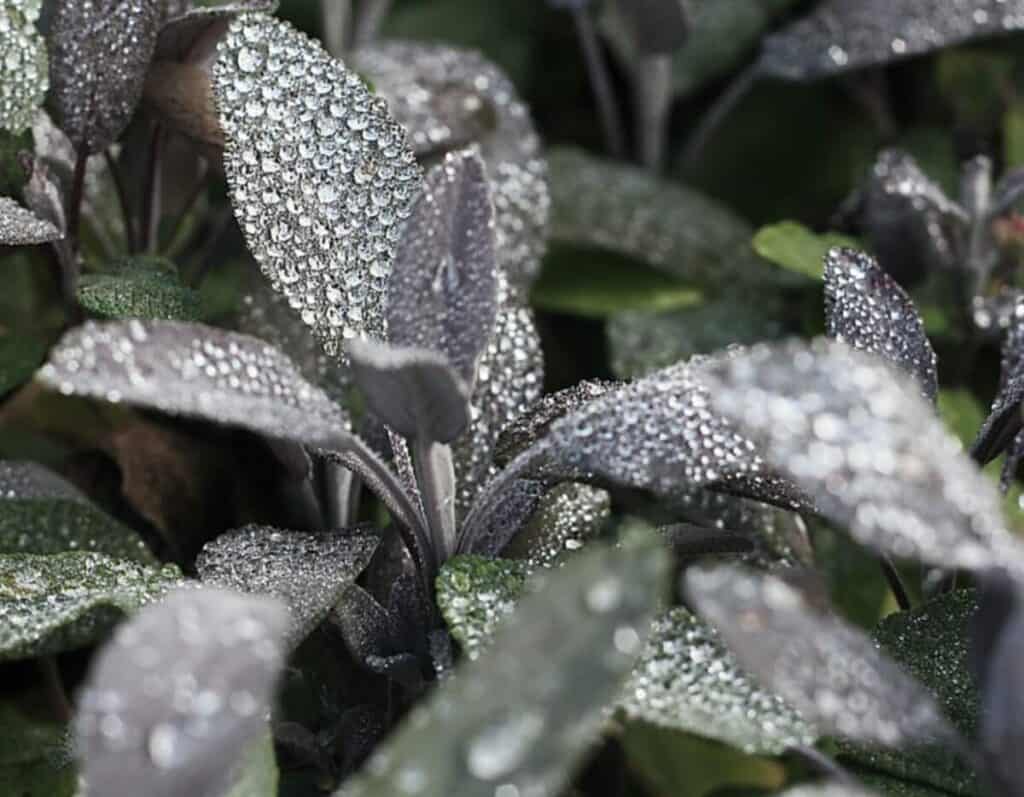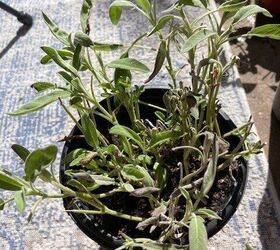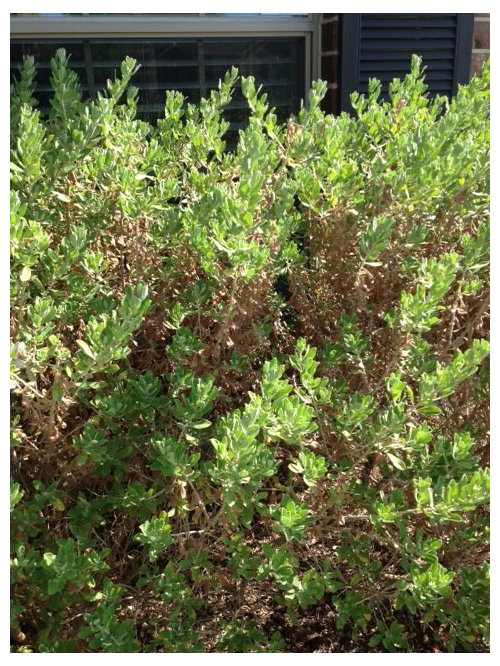Sage plants turn brown due to the fungus root rot, which is brought on by too much moisture around the roots as a result of overwatering or poorly draining soils. Sage develops brown leaves, stems, and roots that appear wilted in the presence of persistently moist soil around its roots.
Sage that is becoming brown (or yellow) is a symptom of stress due to excessively damp soils and not because the sage requires more regular watering which is a typical misunderstanding when cultivating Mediterranean herbs.
Sage typically turns brown for the following reasons:
- watering too much
- sluggish drained soil
- large rains
- Humidity
If your sage is planted in a pot or container, ensure the pot has drainage holes in the base for excess water to escape.
Keep reading to learn more about why sage plants turns brown and how to solve it…
Table of Contents
Slow Draining Soil (Add Sand or Grit to Improve Drainage)
Sage is a Mediterranean herb that naturally thrives on sand-covered hillsides in Southern France where the soil tends to drain swiftly and moisture quickly evaporates in the hot sun.
Sage requires very little maintenance, but in order to mimic the growing conditions of their natural environment, it is crucial that they be planted in soil that drains well and does not retain water.
Sage will not effectively drain away water if it is planted in clay, compacted soil, or rich compost.
Sage requires soil that is excellent draining so that the earth surrounding the roots dries out substantially between bouts of watering.
Root rot is a fungal disease that causes the sage plant to turn brown or yellow and will eventually kill it if left untreated. It is made worse by slow draining soils that retain water around the roots of the plant (read my article on why sage plants wilt and how to solve it).
The solution is to:
- To improve drainage, amend the soil with sand or grit so that it is roughly 20% sand and 80% potting soil.
- Sage should be planted or transplanted into pots with better drainage than garden borders.
Sage grows well in pots because you can simply regulate the soil profile and bring the pot indoors to protect it from cold weather (sage is not very cold hardy).
To give roots room to grow, choose a pot that is approximately 16 inches across.
To prepare or amend the soil for planting sage, that is turning brown you will need to:
- Dig out a planting area of roughly 18 inches x 18 inches (or choose a container of around 16 inches across) (or choose a pot of around 16 inches across). The more soil you can dig, the better for drainage, if the underlying soil is clay that drains slowly.
- After planting the sage, backfill the area with 80% compost or potting soil and at least 20% horticultural sand or grit.
- If the leaves are turning brown, replant the sage and give it a generous watering a week or so later.
Replanting the sage in a soil mixture with good drainage is essential to aid in its recovery. Sage does not always recover from root rot, and it depends on how much of the plant has turned brown.
Over Watering Causes Sage to Turn Brown
Sage is therefore adapted to a tough, arid climate, and once it has established itself, it becomes a drought-resistant plant that actually flourishes in these conditions, especially in terms of the perfume of the leaves and the strong flavor for cooking.
If you water your sage plant too regularly then there will be persistent moisture around the roots which can lead to root rot and the leaves turning brown.
- In the spring and summer, if the weather is warm, water established sage plants that are grown in pots once a week with a generous soak.
- Sage planted in garden soil typically only needs to be watered once every two weeks if the weather is hot and there hasn’t been much significant rainfall, but it depends on the specific conditions of your environment.
- Your sage plant may not need any water at all in locations that are cooler and have more rainfall than the Mediterranean (perhaps only in times of drought), obtaining all the moisture it needs from the surroundings.
- Sage doesn’t need water in the Winter because the plant is in a dormant state; however, if the plant is indoors, water it once every few weeks to prevent it from drying out completely.
Sage prefers to be watered in a soak and dry manner since this stimulates the roots to grow and establish. Water abundantly but sparingly to prevent root rot and browning of the leaves.
Since sage likes drier soil, overwatering causes more issues than underwatering.
Sage needs to reduce watering and improve drainage in order to recover from its brown appearance.
High Rainfall
Sage prefers a dry area with little rainfall, but with a few adaptations to the environment, it can flourish in a wide range of diverse habitats.
Sage can thrive in the wet Pacific Northwest regions of the United States and the United Kingdom.
The soil conditions, however, become even more crucial in regions with significant rainfall in order to prevent root rot and browning of the leaves by ensuring that excess water can drain away from the sage roots effectively.
In rainy climates, sage that is grown outdoors frequently doesn’t need any additional water, so avoid overwatering to keep the plant healthy and guarantee the flavor of the leaves.
There are two things you may do if heavy rains are causing your sage to turn brown:
- Add a significant amount of sand or grit to the soil (up to 50% sand to 50% compost).
- Plant sage in a pot and shield it from persistent rainfall where possible.
Sage needs well-draining soil to develop, but in rainy climates, root rot prevention is especially vital.
Sage grows in very sandy soils on hill slopes and thrives in its original environment with fast-draining soil conditions, therefore 50% sand in a soil mixture may not appear excessive.
When it comes to producing Mediterranean herbs, too much sand or grit is always preferable to not enough.
In wet areas, it is always recommended to plant in pots and containers since they have better drainage than garden soil and prevent the roots from being encircled by soggy soil.
Sage should be protected from anticipated additional rainfall if its leaves are turning brown because this will exacerbate the root rot issue.
If given enough time, the earth around the roots can dry out, allowing the sage to start healing.
Climates with higher levels of Humidity
Sage plants can struggle with high humidity levels because of the slower rate of evaporation, which increases the likelihood that the soil surrounding the roots will remain damp for longer.
Sage plants should always be planted in pots and spaced around 2-3 feet apart from one another if you want to grow them in a humid environment. This separation allows air to circulate around the plants and prevents the micro climate that can develop when a lot of potted plants are close together.
How to Save Brown Sage Plants
The best course of action if the sage plant is noticeably going brown is to:
- Using sterile pruners, remove any damaged stems and leaves.
- To stop the spread of a fungal infection, wipe the pruners with a disinfectant-coated towel after each snip of the plant.
- Instead of adding the impacted brown foliage to a compost pile, burn or discard it.
- If it is possible to remove the plant from the soil, look at the roots and remove those that are sticky and brown because they are infected. After each snip, be sure to wipe the pruners.
- Reduce watering, add sand or grit to the soil to aid drainage, protect the plant from heavy rain, and space pots about 2-3 feet apart from one another to help the sage recuperate.
If you want to save the plant, you can also clip off some of the healthy growth and use it for propagation. Sage and other Mediterranean herbs can be easily and affordably propagated; for a helpful tutorial, view this YouTube video:
Key Takeaways:
- Root rot causes the browning of sage plants. Brown leaves, brown stems, and a drooping appearance are signs of root rot. Due to overwatering or poorly draining soils, there is too much moisture surrounding the roots, which leads to root rot.
- Sage leaves can turn brown due to root rot, and excessive rainfall and humidity can also significantly contribute to the circumstances that encourage root rot.
- Sage should be planted in areas with slow-draining soil or excessive humidity; make sure the soil is supplemented with sand or grit; reduce watering; and place the pots 2-3 feet apart to allow for ventilation.
- With a pair of pruners, remove the diseased, brown leaves, and let the soil around the roots dry out so that the sage can recuperate.
FAQ
What causes a leaf to curl?
Many issues, such as insect damage, disease, abiotic conditions, or even herbicides, can result in curled leaves. When they suck plant juices from fresh or young leaves that are still growing, a variety of insect pests cause the leaves to curl. These include aphids, thrips, and whiteflies. Whiteflies have two different ways in which they might harm a plant. The first is regarded as “direct” harm. Whiteflies can cause serious damage to plants by sucking their juices, which makes their leaves turn yellow, shrivel, and drop off too soon. Controlling Whiteflies in Your Garden – UC ANRhttps://ucanr.edu/Controlling Whiteflies in Your GardenControlling Whiteflies in Your GardenControlling Whiteflies in Your Garden
How can you tell if sage is overwatered?
If your sage is overwatered, it will become drooping and its leaves will begin to turn yellow. Root rot, which occurs when the roots start to decompose and die, may potentially affect the plant. Your sage plant may have white powder on its leaves, which is an indication of mildew.
What does it mean if my plant leaves are curling?
Too much direct sun or heat can cause heat stress in plants, which is why they try to retain moisture by curling their leaves, according to Richard Cheshire, the plant doctor at Patch.
Can you over water sage?
Sage favors dry soil, thus it is easily overwatered. Common overwatering symptoms include wilting and drooping. If the plant is consistently overwatered, sage leaves may turn yellow, brown, or even black. Watch out for root rot, which is typically caused by too much water.



